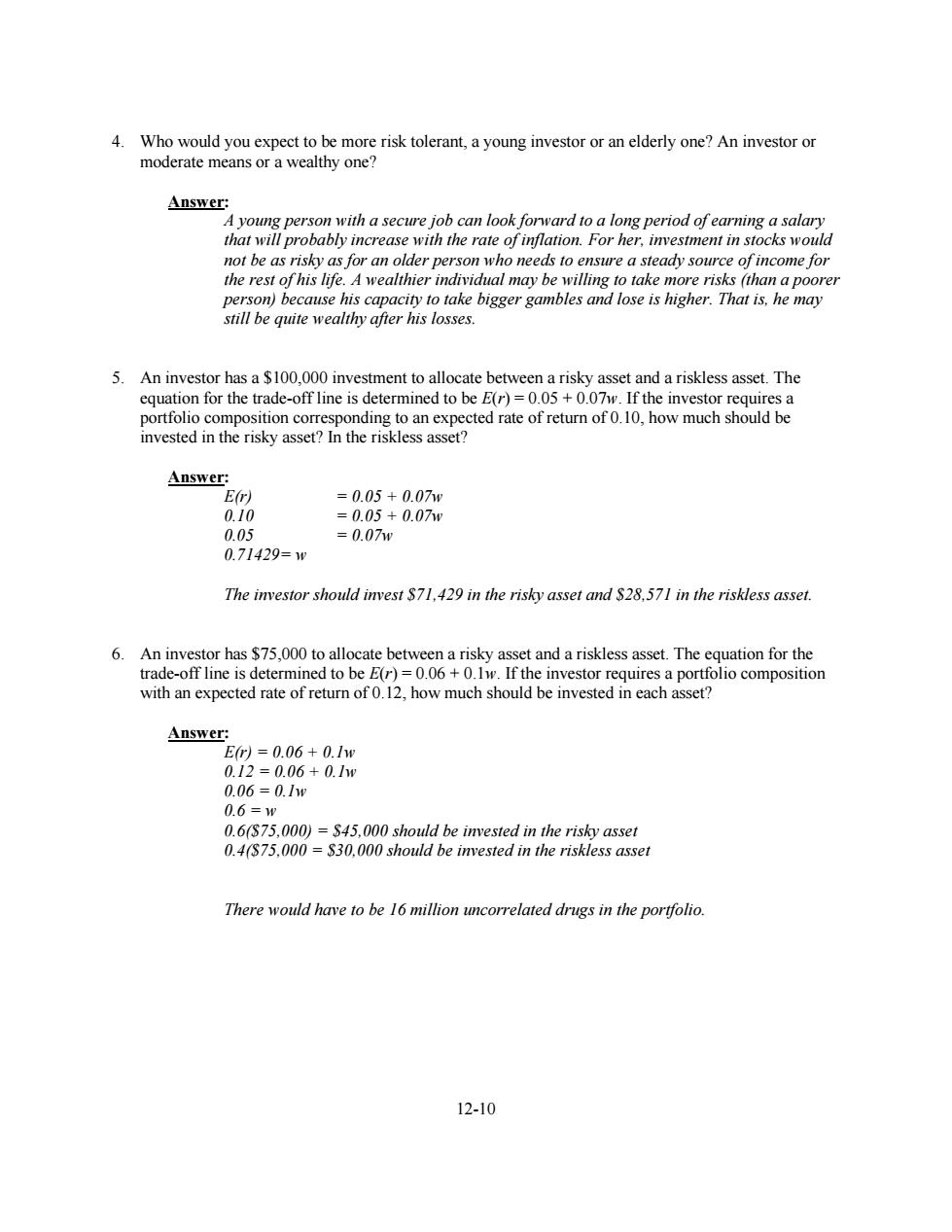正在加载图片...

4.Who would you expect to be more risk tolerant,a young investor or an elderly one?An investor or moderate means or a wealthy one? Answer: A young person with a secure job can look forward to a long period of earning a salary that will probably increase with the rate of inflation.For her,investment in stocks would not be as risky as for an older person who needs to ensure a steady source of income for the rest of his life.A wealthier individual may be willing to take more risks (than a poorer person)because his capacity to take bigger gambles and lose is higher.That is,he may still be quite wealthy after his losses. 5.An investor has a $100,000 investment to allocate between a risky asset and a riskless asset.The equation for the trade-off line is determined to be E(r)=0.05+0.07w.If the investor requires a portfolio composition corresponding to an expected rate of return of 0.10,how much should be invested in the risky asset?In the riskless asset? Answer: E(r) =0.05+0.07w 0.10 =0.05+0.07w 0.05 =0.07w 0.71429=w The investor should invest $71,429 in the risky asset and $28.571 in the riskless asset. 6.An investor has $75,000 to allocate between a risky asset and a riskless asset.The equation for the trade-off line is determined to be E(r)=0.06 +0.1w.If the investor requires a portfolio composition with an expected rate of return of 0.12,how much should be invested in each asset? Answer: Er)=0.06+0.1w 0.12=0.06+0.1w 0.06=0.1w 0.6=w 0.6(S75,000)=S45,000 should be invested in the risky asset 0.4(S75,000 S30,000 should be invested in the riskless asset There would have to be 16 million uncorrelated drugs in the portfolio. 12-1012-10 4. Who would you expect to be more risk tolerant, a young investor or an elderly one? An investor or moderate means or a wealthy one? Answer: A young person with a secure job can look forward to a long period of earning a salary that will probably increase with the rate of inflation. For her, investment in stocks would not be as risky as for an older person who needs to ensure a steady source of income for the rest of his life. A wealthier individual may be willing to take more risks (than a poorer person) because his capacity to take bigger gambles and lose is higher. That is, he may still be quite wealthy after his losses. 5. An investor has a $100,000 investment to allocate between a risky asset and a riskless asset. The equation for the trade-off line is determined to be E(r) = 0.05 + 0.07w. If the investor requires a portfolio composition corresponding to an expected rate of return of 0.10, how much should be invested in the risky asset? In the riskless asset? Answer: E(r) = 0.05 + 0.07w 0.10 = 0.05 + 0.07w 0.05 = 0.07w 0.71429= w The investor should invest $71,429 in the risky asset and $28,571 in the riskless asset. 6. An investor has $75,000 to allocate between a risky asset and a riskless asset. The equation for the trade-off line is determined to be E(r) = 0.06 + 0.1w. If the investor requires a portfolio composition with an expected rate of return of 0.12, how much should be invested in each asset? Answer: E(r) = 0.06 + 0.1w 0.12 = 0.06 + 0.1w 0.06 = 0.1w 0.6 = w 0.6($75,000) = $45,000 should be invested in the risky asset 0.4($75,000 = $30,000 should be invested in the riskless asset There would have to be 16 million uncorrelated drugs in the portfolio